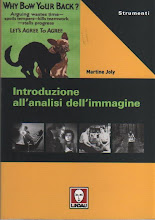lunedì 14 dicembre 2009
On December 11th it was one year since Fred left us
All Fred's friends who want to remember him are welcome.
Daniele
mercoledì 25 novembre 2009
Lodovico interviews Diana Borrego Martinez Gonzalez
martedì 24 novembre 2009
The photo exhibit, dedicated to Fred Iltis. World première
On November 17, 2009 the photo exhibit, dedicated to Fred Iltis, was inaugurated in the city of Milan. It was an absolute world première, conceived and realized by two of his friends Daniele Ravenna and Felix Humm. There was a significant amount of Italian media coverage, such as the Corriere della Sera, la Repubblica, and Radio Popolare. Many visitors came to see the exhibit on opening night, it was truly remarkable, and still more people continue to visit the Azalai Bookstore where the photos are still on exhibit.
I made this video on the day after the opening, so that at least the bloggers can have a “small” impression of where and how Fred’s photos were eventually shown to the public. I do hope this modest effort of mine will be appreciated by all those friends who are following this work which I am dedicating with passion to Daniele and Felix’s friend who passed away.
Thank you guys, this is the way to do it!
venerdì 20 novembre 2009
Tra le cose ancora tutte da scoprire di Fred Iltis
Mi ha raccontato Diana Borrego Martinez Gonzalez, arrivata dalla California per la mostra di Milano, che el Tio Fred, oltre a metterci la propria particolare sensibilità quando stampava con l'archival process, aveva due occhi in più al suo fianco: quelli della moglie Julia, artista grafica e disegnatrice di grande talento,la cui familiarità con i chiari scuri nobilitava attraverso i suggerimenti dati a Fred il già raffinato bianconero del fotografo, che è stato definito pregevole dal critico Roberto Mutti nella recensione apparsa sul quotidiano "Repubblica".
Daniele Ravenna
giovedì 19 novembre 2009
La Mostra di Fred Iltis.wmv
Il 17 novembre c’è stata l’inaugurazione della Mostra dedicata al fotografo Fred Iltis. E’ stata una prima assoluta mondiale voluta, studiata e realizzata da due suoi amici, Daniele Ravenna e Felix Humm. Della Mostra hanno parlato molti importanti media italiani, come Il Corriere della Sera, La Repubblica e Radio Popolare. L’affluenza di visitatori è stata considerevole e anche in questi giorni sono molte le persone che si sono recate alla Libreria Azalai, luogo che ospita la mostra. Ho realizzato questo video il giorno dopo, così da offrire a tutti quelli che leggono il blog, la possibilità di avere una “piccola” impressione di come e dove le foto di Fred si sono finalmente aperte al pubblico. Spero che questo mio modesto sforzo sia gradito a tutti gli amici che stanno seguendo il mio lavoro che faccio e dedico con passione all’amico, ormai scomparso, di Daniele e Felix. Grazie ragazzi, così si fa!
giovedì 12 novembre 2009
A Trattoria on Via San Giovanni sul Muro.
mercoledì 11 novembre 2009
Fred Iltis’s photos will soon be on the walls!
martedì 10 novembre 2009
La Mostra di Fred nei Colori delle Culture
 Questa città ha una storia antica più vivace e vicina al cielo dei suoi futuri grattacieli. Nei suoi vicoli è possibile scoprire la capacità dei suoi abitanti di raccogliere e offrire cultura. Una cultura che rompe le barriere e apre lo sguardo al Mondo, così come le foto di Fred Iltis.
Questa città ha una storia antica più vivace e vicina al cielo dei suoi futuri grattacieli. Nei suoi vicoli è possibile scoprire la capacità dei suoi abitanti di raccogliere e offrire cultura. Una cultura che rompe le barriere e apre lo sguardo al Mondo, così come le foto di Fred Iltis.sabato 24 ottobre 2009
Una trattoria in Via San Giovanni Sul Muro.
mercoledì 21 ottobre 2009
Finalmente!
giovedì 8 ottobre 2009
Con un libro di studio in mano
Leggendo l’intensità delle prime pagine che descrivono l’orrore indescrivibile del “lavoro” degli uomini dei Sonderkommando, Didi-Huberman mi ha ricordato che le immagini sono l’unica possibilità per avvicinarsi al più terribile degli eventi che mente umana abbia potuto concepire e mettere in atto. La realtà per molti inimmaginabile e inesprimibile dei campi di sterminio nazisti attraverso le immagini diventa concreta ed è impossibili sfuggire a essa e alle nostre responsabilità.
giovedì 1 ottobre 2009
La vita di Fred Iltis
Nella foto Fred Iltis da giovane.
martedì 29 settembre 2009
Scrivete!
venerdì 25 settembre 2009
Intervista a un esperto di storia dell'iconografia
giovedì 24 settembre 2009
Macchine del tempo
Questo Fred Iltis lo sapeva molto bene e come scrive Daniele Ravenna «Quando prendeva in mano le sue foto, allora come nel 2008, s’infilava sempre i guanti di cotone bianchi e le trattava come delicate creature viventi che vanno protette, da cui è difficile separarsi».
Infatti, tutte le pagine che raccontano una storia vivono, perché sono proiettate nel futuro, vere “macchine del tempo”.
mercoledì 23 settembre 2009
Primo Editoriale
Lodovico Valentini Perugia








